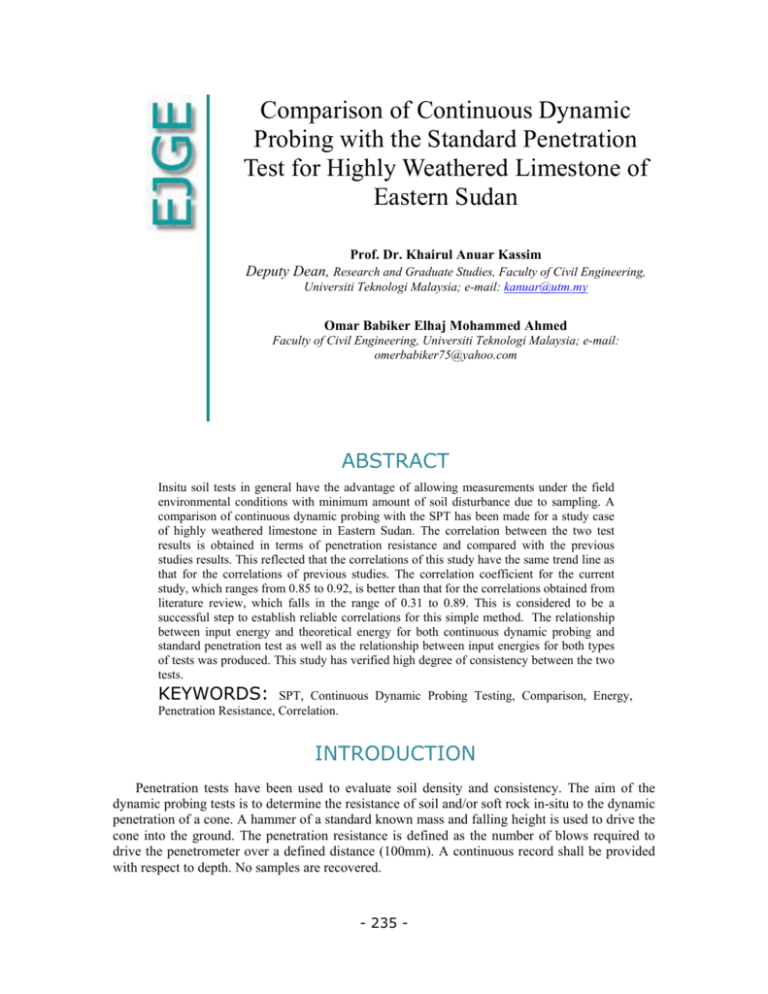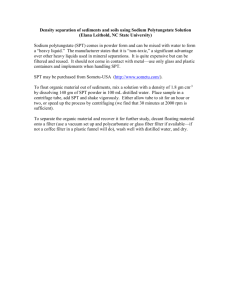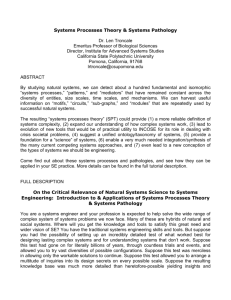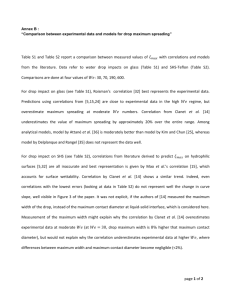Get the entire paper
advertisement

Comparison of Continuous Dynamic Probing with the Standard Penetration Test for Highly Weathered Limestone of Eastern Sudan Prof. Dr. Khairul Anuar Kassim Deputy Dean, Research and Graduate Studies, Faculty of Civil Engineering, Universiti Teknologi Malaysia; e-mail: kanuar@utm.my Omar Babiker Elhaj Mohammed Ahmed Faculty of Civil Engineering, Universiti Teknologi Malaysia; e-mail: omerbabiker75@yahoo.com ABSTRACT Insitu soil tests in general have the advantage of allowing measurements under the field environmental conditions with minimum amount of soil disturbance due to sampling. A comparison of continuous dynamic probing with the SPT has been made for a study case of highly weathered limestone in Eastern Sudan. The correlation between the two test results is obtained in terms of penetration resistance and compared with the previous studies results. This reflected that the correlations of this study have the same trend line as that for the correlations of previous studies. The correlation coefficient for the current study, which ranges from 0.85 to 0.92, is better than that for the correlations obtained from literature review, which falls in the range of 0.31 to 0.89. This is considered to be a successful step to establish reliable correlations for this simple method. The relationship between input energy and theoretical energy for both continuous dynamic probing and standard penetration test as well as the relationship between input energies for both types of tests was produced. This study has verified high degree of consistency between the two tests. KEYWORDS: SPT, Continuous Dynamic Probing Testing, Comparison, Energy, Penetration Resistance, Correlation. INTRODUCTION Penetration tests have been used to evaluate soil density and consistency. The aim of the dynamic probing tests is to determine the resistance of soil and/or soft rock in-situ to the dynamic penetration of a cone. A hammer of a standard known mass and falling height is used to drive the cone into the ground. The penetration resistance is defined as the number of blows required to drive the penetrometer over a defined distance (100mm). A continuous record shall be provided with respect to depth. No samples are recovered. - 235 - Vol. 15 [2010], Bund. B 236 Standard Penetration Test, commonly known as the (SPT) is another insitu dynamic testing method. This test is one of the most popular and widespread methods of insitu soil investigation all over the world. It is carried out in a borehole by driving a standard “spilt spoon” sampler by the blows of a standard automatic hammer that falls freely from a standard known height. The test results are usually recorded as the number of blows per 300mm penetration [Clayton, 1995]. The test results have correlations for shear parameters, density and deformation of the soil. Both dynamic probing and standard penetration tests are very useful in cohesionless soils. PREVIOUS CORRELATIONS FOR DYNAMIC PROBING Many correlations have been established between the different dynamic probing tests and between them and other tests or geotechnical parameters. In some instances the friction along the rods has been either eliminated or corrected, but there are no records about the measurement of the actual energy transmitted to the probe. Hence, they cannot be considered valid in general [BS EN 1997-2:2007]. Card and Roche (1990), in UK produced correlations of heavy weight dynamic probing test (DPH, SRS15) with the Standard Penetration Test (SPT) for chalk and three types of noncohesive deposits. They considered a simplified theoretical correlation between DPN300 and SPT N300 as follows: DPN300 = K1 SPT N300 The proportionality constant and correlation coefficient for different subsurface materials were determined using statistical analysis as illustrated in Table 1 Table 1: Proportionality constants, K1 and correlation coefficients r for SPT N300 and DPN300 values Deposit K1 r Chalk 1.4 0.78 Reading Beds: sand 1.4 0.75 Alluvial gravel 1.0 0.31 Flood plain gravel 1.1 0.8 Spagnoli (2008) described the correlation of the Super Heavy Dynamic Penetrometer (DPSHISSMFE) with the SPT that was produced by Muromachi and Kobayashi, 1982. N30 = 1.15NSPT where N30: Dynamic Probing N value (Number of blows per 30 cm penetration) Craig [1996], also mentioned that A.P. Bucher presented a correlation between dynamic probing tests (DPH) and standard penetration tests that were carried out at 10 sites consisted of clay soils in UK and Norway: N′ = 8N10 – 6 Vol. 15 [2010], Bund. B 237 GEOLOGY OF THE AREA This research has been focused in a specific area in eastern Sudan. This area represents the second city and the main Sea port in Sudan. It is namely Portsudan, which is located in western coast of the Red Sea in eastern Sudan. This area generally has similar uniform stratification that undergoes slightly variations in few points. This generally comprises of highly weathered to moderately weathered coral reef limestone that contains marine shells and fossils. In some few locations, this limestone layer is overlain by relatively thin layer of residual soil that is due to weathering and accumulating of the limestone, which is dominant in this area. The thickness of the upper residual soil generally about 1.0 m, sometimes reaches to about 2m. The subsurface formation in the present area is generally alkaline containing relatively high amount of sulphate and chloride. The carbonate is also available in these subsurface layers with high percentages The groundwater in the studied area is noted to be as shallow saline groundwater, which was encountered in the depth range 1.03 to 1.3 m below existing ground level. Both dynamic probing test and standard penetration test that were used in this research are started from 1.5m depth below the existing ground level. Therefore, all tests are carried below groundwater level. METHODOLOGY The data of the tests results, for this study, was collected from the site investigation report of the RED SEA PORTS CORPORATION GENERAL HOSPITAL PROJECT within the area specified for the research. The site investigation and geotechnical reporting for this site were carried out in August 2008 by one of the biggest geotechnical firms in Sudan, which is known as Engineering Services and Design (ESD). The standard penetration test was carried out according to the ASTM D1586. The equipment that were used for the continuous dynamic probing in general conforms to the light dynamic penetrometer (DPL) specified in German standard DIN 4094 with exemption of the hammer weight, which is equivalent to 20 kg instead of 10 kg. It is actually modified light dynamic penetrometer (DPL)mod. About sixty seven (67) points (from each test) will be considered in this study. The following flow charts in Fig. 1 and Fig. 2 illustrate the steps that were followed to attain the objective of this study: Vol. 15 [2010], Bund. B Figure 1: Flow Chart for Producing of (DPL) mod. versus SPT Correlations 238 Vol. 15 [2010], Bund. B 239 Figure 2: Flow Chart for Comparison of Energy ENERGY CALCULATION The input energy for SPT was calculated according to the energy calibration study carried by Kovacs (1983), which stated that the energy ratio transferred to the SPT sampler by the donut hammer per each blow is about 0.45 of the hammer fall energy [Sherif and Rose , 2001]. The theoretical free fall energy of an SPT hammer can be determined as follows: E = wh (1) For dynamic probing the force, which acts on the cone tip was calculated according to International Society for Soil Mechanics and Foundation Engineering [Clayton, 1995 and Tony, 2005 ], then multiplied by the distance that was penetrated by the cone (300mm) to produce the input energy. rd = (2) The above equation calculates the mean stress acts on the cone when it is pushed downward. Therefore, the force (F) acts on the cone can be calculated as follows: Vol. 15 [2010], Bund. B 240 F = rd*A (3) And the driving work or input energy to drive the cone a distance of 300mm (0.3m) can be calculated as follows: EDP(in) = F*0.3 = rd*A*0.3 (4) The theoretical energy of both SPT and dynamic probing was calculated utilizing two pile driving formulas so as to choose the most representative one. The two formulas are namely Engineering News formula [Craig, 1996] and the pile driving formula after Gates (1957) [Richard, jerry and Evert, 1985] The ENR equation as reported by Peck, et al. is specifically as follows [Tony 2005]: Ra = H ( ) (5) where Ra = allowable (working) pile resistance measured during driving WH = weight of the hammer ram, expressed in the same units as Ra H= height of fall of the ram (i.e., its stroke), expressed in the same units as s and C s= pile permanent set (the average penetration per blow), (IN) C = energy loss per hammer blow, (0.1 IN for all hammers except drop hammers and 1.0 IN for drop hammers) FS = factor of safety, recommended as 6.0. The pile driving formula after Gates (1957) has been mentioned by Dr. Richard J. Fragaszy, et al. (1985): Ru = 27 e h E h (1 − log s ) (6) where Ru : Ultimate bearing capacity of pile in soil (kips) eh is efficiency of striking hammer; 0.75 for drop hammer, 0.85 for all other hammers Eh: hammer energy (ft-kips) s: as defined for equation (5), (inches) TYPES OF CORRELATIONS Two types of correlations have been established: 1- DPN300 versus SPT-N300: in this case the individual DPN100 values were summed over consecutive 300 mm intervals corresponding to the equivalent SPT undertaken in the adjacent paired hole. Vol. 15 [2010], Bund. B 241 2- DPN100 versus SPT-N300 in this case, the dynamic probing blow counts were averaged over the depth increment that closely matched those used for SPT (with exemption seating drive). Statistical analysis was used to obtain the correlations between the above-mentioned variables, which are subject to scattering. An attempt to determine the coefficients of the correlations was made by constructing many trend lines for each of the two correlations. Based on the above analysis results the most suitable correlation and correlation coefficient, as shown in Table 2, figures 3 and 4, have been obtained for all the selected data. The best trend line is the linear correlation without intercept. Table 2: Correlation of Light modified dynamic probing (DPLmod) with SPT Linear Relationship Correlation Type Y = aX Coefficient Coefficient of of correlation correlation (R2) (R) DPN300 versus SPT-N300 DPN300 = 2.44 SPT-N300 0.734 0.857 DPN100 versus SPT-N300 SPT-N300= 1.43 DPN100 0.849 0.921 120 110 100 90 SPT N300 80 70 60 50 40 x = 2.44y R² = 0.734 30 20 10 0 0 20 40 60 80 100 120 140 160 180 200 220 240 260 DPT N300 Figure 3: Correlation of Light modified dynamic probing (DPN300) with SPT Vol. 15 [2010], Bund. B 242 240 220 200 180 DPT N100 160 140 120 100 80 60 y = 1.253x1.083 R² = 0.730 40 20 0 0 10 20 30 40 50 60 70 80 90 100 SPT N300 Figure 4: Correlation of Light modified dynamic probing (DPN300) with SPT COMPARISON WITH PREVIOUS CORRELATIONS Some of the similar previous studies that are summarized in Table 3 have indicated the general trend of linear correlation without intercept. The correlations produced in this study have also indicated the same trend line (linear correlation), which is the best one. The linear relationship is found in the form of DPN300 = K1 SPT N300. The proportionality constant, K1 for this research is about 2.44, whereas for the previous studies was found in the range of 1.0 to 1.4. This is most probably due to the deference in the studied subsurface materials as well as the type of penetrometer used in the correlation with SPT. In the previous researches, Heavy weight dynamic penetrometer (DPH, SRS 15) and Super Heavy dynamic penetrometer (DPSH) were used, whereas the Modified Light dynamic penetrometer was used in this research. The investigated subsurface materials in the studies carried in the past are chalk, sand, alluvial gravel and flood plain gravel. The current study has been carried out for the highly weathered limestone. Vol. 15 [2010], Bund. B 243 Table 3: Comparison with similar correlation from previous studies (DPN300 versus SPT300) Deposit Highly weathered limestone in Correlation Correlation Proportionality Coefficient R Constant, K1 0.86 2.44 0.78 1.4 0.75 1.4 0.31 1.0 0.8 1.1 - 1.15 DPN300 = 2.44 SPT N300 (DPL mod versus SPT) Sudan ( Current Research) Chalk in UK DPN300 = 1.4 SPT N300 ( 1990 ) (DPH versus SPT) Reading Beds: sand in UK DPN300 = 1.4 SPT N300 ( 1990 ) (DPH versus SPT) Alluvial gravel in UK DPN300 = 1.0 SPT N300 ( 1990 ) (DPH versus SPT) Flood plain gravel in UK DPN300 = 1.1 SPT N300 ( 1990 ) (DPH versus SPT) Gravel and Sand in Germany DPN300 = 1.15 SPT N300 ( 2008 ) (DPSH versus SPT) From the comparisons given in Tables 3 and 4, it can be said that this research has produced correlation results better than those were obtained from the literature review. This is reflected by the correlation coefficient, which ranges from 0.85 to 0. 0.92 for the current research correlations, whereas for the correlations obtained from literature review, it falls in the range of 0.31 to 0.89. Table 4: Comparison with similar correlation from previous studies (DPN100 versus SPT300) Correlation Deposit Highly weathered limestone in Sudan ( Current Research) Stiff clay in UK. and Norway (1996) Correlation SPT-N300= 1.43 DPN100 (DPL mod versus SPT) N′ = 8N10 – 6 Coefficient R 0.92 0.89 (DPH versus SPT) Slightly plastic clay above groundwater NSPT = 1.0 N10 + 3 in Germany (2008) (DPH versus SPT) - The result of the above-mentioned comparison supports the idea of this research and it is considered to be a successful step to establish reliable correlations for this simple method. This study has verified high degree of consistency between the two tests. Vol. 15 [2010], Bund. B 244 Figure 5: Comparison between the current research correlation and previous correlations (SPT versus DPN300) Vol. 15 [2010], Bund. B 245 80 75 70 65 60 55 DPT N10 50 `N`= 0.701N10 R² = 0.849 45 DPLmod. for H.W Limestone-Sudan Current Research 40 DPH for Stiff Clays of Canons Park and Cowden in U.K. 35 30 25 20 15 `N`= 8N10-6 R² = 0.802 10 5 0 0 20 40 60 80 100 120 140 160 180 SPT 'N' Figure 6: Comparison between the current research correlation and previous correlations (DPT N10 versus SPT ‘N’) ENERGY RELATIONSHIPS The relationships of the energy are shown in Table 5. It is found that the Engineering News Record (ENR) formula is the most suitable to represent the SPT theoretical energy, whereas for the dynamic probing theoretical energy the formula after Gates (1957) is better than ENR formula, where, the definition of symbols in Table 5 is as follows: ESPT (th): Theoretical Energy for SPT based on pile driving formulas ESPT (in): Input Energy for SPT based on the test results EDP (th): Theoretical Energy for Dynamic Probing based on pile driving formulas EDP (in): Input Energy for Dynamic Probing based on the test results Vol. 15 [2010], Bund. B 246 Table 5: Energy Relationship Relationship Correlation Equation Type Pile driving Correlation formula used for Coefficient theoretical energy R calculation ESPT(th) versus SPT Engineering ESPT(th) = 0.001 ESPT(in)3 - 0.064 ESPT(in) (polynomial News Record 2 ESPT(in) + 2.136 ESPT(in) + 0.086 of order 3) EDP(th) versus EDP(in) 0.331 (ENR) Gates formula EDP(th) = 6.156 EDP(in) (Power) EDP(in) versus ESPT(in) 1.00 EDP(in) = 0.996 ESPT(in) 0.98 (1957) - 0.89 30 Theoretical Energy SPT, kN.m 27 y = 0.001x3 - 0.064x2 + 2.136x + 0.086 R² = 1 24 21 18 15 12 9 6 3 0 0 2 4 6 8 10 12 14 16 Input Energy SPT, kN.m 18 20 22 Figure 7: Relationship of Theoretical Energy versus Input Energy of SPT *Note: Engineering News Record (ENR) pile driving formula was used to calculate the SPT theoretical energy Vol. 15 [2010], Bund. B 247 20 18 y = 6.156x0.331 R² = 0.957 Theoretical Energy DPT kips-ft 16 14 12 10 8 6 4 2 0 0 2 4 6 8 10 12 14 16 18 20 Input Energy DPT kips-ft Figure 8: Relationship of Theoretical Energy versus Input Energy of DPT *Note: - Pile driving formula after Gates (1957) was used to calculate the DPT theoretical energy 30 27 y = 0.996x R² = 0.786 DPT Input Energy, kN.m 24 21 18 15 12 9 6 3 0 0 2 4 6 8 10 12 14 16 18 20 22 SPT Input Energy, kN.m Figure 9: Relationship of Input Energy of DPT versus Input Energy of SPT Vol. 15 [2010], Bund. B 248 CONCLUSIONS In this paper, a comparison between continuous dynamic probing (Light modified type) and standard penetration test was carried out for a case study of highly weathered limestone in Eastern Sudan. Statistical analysis was used to produce the DPLmod versus SPT correlations. The analysis indicated linear trend line without intercept for these correlations as follows: DPN300 = 2.44 SPTN300 SPT-N300 = 1.43 DPN100 The obtained correlations were compared to some previous similar correlations. This comparison indicated that this study produced correlations that have the same trend line as that for the previous studies. The correlations produced in this study have coefficient ranging from 0.85 to 0.92, whereas the correlations obtained from the literature have coefficients that range from 0.31 to 0.89. This comparison supports the idea of this study and is considered as a successful step for producing correlations for this simple method. The energy relationships were also produced. It is found that the Engineering News Record (ENR) formula is the most suitable to represent the SPT theoretical energy, whereas for the dynamic probing theoretical energy the formula after Gates (1957) is the best one. This study has verified high degree of consistency between the two tests. REFERENCES 1. Dr. Richard J. Fragaszy, Principle Investigator, Dr. jerry D. Higgins, Co-Investigator, Mr. Evert C. Lawton, Research Assistant, (1985) “Development of guidelines For Construction Control of Pile Driving and Estimating of Pile Capacity, (Phase 1)” Washington State Transportation Center Department of Civil Engineering, Washington State University Pull man, WA 99164 - 3001 2. C. R. I. Clayton, M. C. Matthews and N. E. Simons, July-1995 “Site Investigation, (2nd Edition)” Department of Civil Engineering, University of Surrey, United Kingdom. 3. M. Sherif Aggour and W. Rose Radding , 2001, Department of Civil and Environmental Engineering University of Maryland College Park, Md 20742 “Standard Penetration Test Correction” 4. Tony M. Allen, P.E ., 2005, Washington State Department of Transportation, Olympia, Washington, Development of the WSDOT Pile Driving Formula and Its Calibration for Load and Resistance Factor Design (LRFD)” 5. British Standard Institution. Euro code 7 — Geotechnical design — Part 2: Ground investigation and testing. London. BS EN 1997-2:2007. Vol. 15 [2010], Bund. B 249 6. Card G.B. & Roche D.P. (1990). The Use of Continuous Dynamic Probing in Ground Investigation. Penetration Testing in the UK. Thomas Telford, London 7. Spagnoli. G. (2008). An Empirical Correlation Between Different Dynamic Penetrometers. EJGE. 2008. Vol. No. p. 1-12 8. Butcher. A. P., McElmeel. K. and Powell. J. J. M. Dynamic Probing and its use in clay soils. In: Craig C. Advances in Site Investigation Practice. London: Thomas Telford. 383-395; 1996. © 2011 ejge






